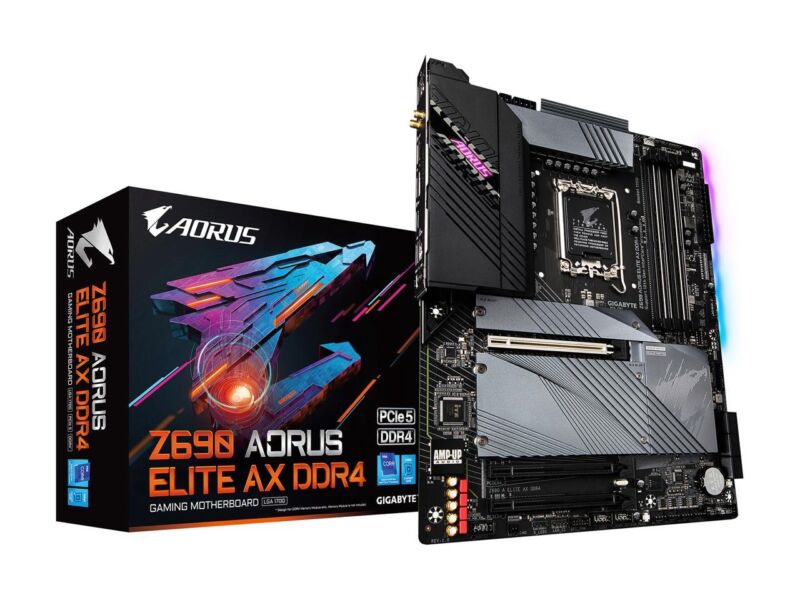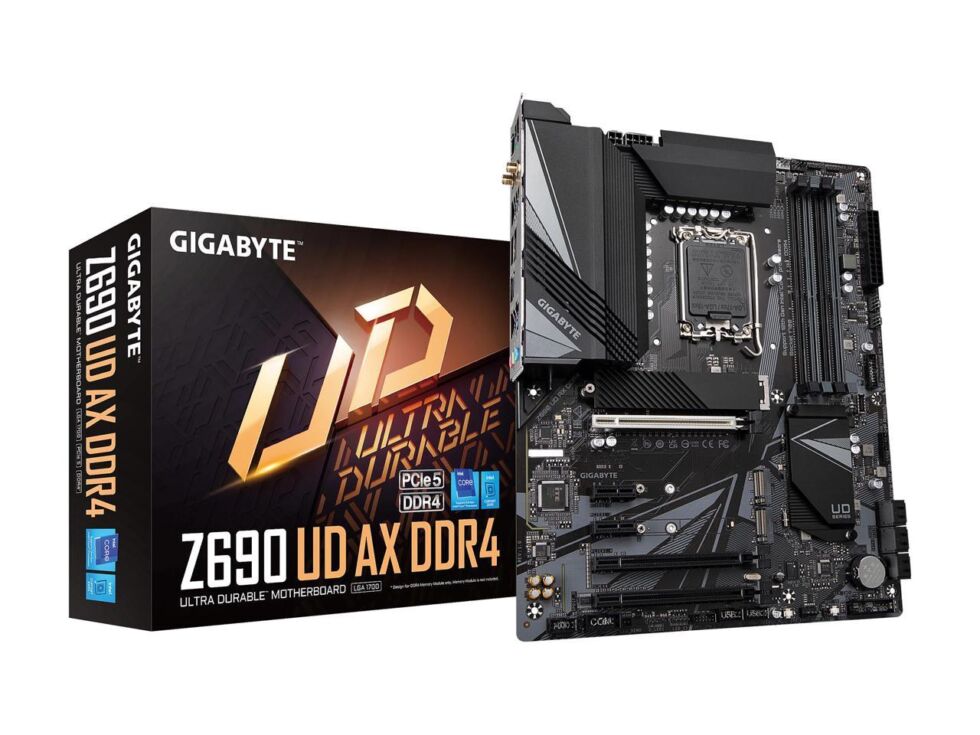DDR4? DDR5? Wi-Fi? A brief overview of motherboards for Intel’s new Alder Lake CPUs

Intel’s 12th-generation Core processors for desktops are here, and they’re fast. Codenamed Alder Lake, these processors consume a lot of power to reach the heights that they do and will require expensive high-performance cooling to match. But in exchange, they deliver healthy single-threaded performance boosts over their closest competition from AMD, and they generally come pretty close in multi-threaded performance tests despite the use of lower-performance “efficiency” cores (or E-cores).
As they so often do, this new processor architecture requires new chipsets and processor sockets from Intel—motherboards with 500-series chipsets aren’t compatible. To accompany our Alder Lake review, we’ve looked at the breadth of Z690-based motherboards that are currently available, as well as the state of the nascent DDR5 RAM market (spoiler: it’s not great).
All kinds of boards

Entry-level ATX and Micro ATX motherboards with the Z690 chipset start between $200 and $250. There are a few that dip below that $200 line, but they’re more likely than the other models to be sold out as of this writing. In general, we tried to focus on boards that you can actually buy right this minute; Newegg lists most ASRock and many Asus motherboards as out of stock right now, but you can still find boards to fit most budgets if you need one.
Even entry-level Z-series motherboards come with their fair share of bells and whistles—truly bare-bones motherboards are reserved for cheaper chipsets that Intel hasn’t announced or released yet. In this price range, you generally get four DDR4 memory slots, though a couple (like the MSI Pro Z690-A DDR5 and Z690-A WIFI DDR5) do offer four DDR5 memory slots instead, as well as a PCI Express 5.0 x16 slot for GPUs, a couple of display outputs (usually one DisplayPort, one HDMI), and three or four M.2 2280 slots for installing multiple SSDs.
You also get somewhere between six and 10 rear USB ports with a mix of speeds, usually with a single USB-C port among them. Most include a single 2.5 Gbps Ethernet port at this point, though you’ll still see 1 Gbps on the very cheapest boards. Built-in Wi-Fi and Bluetooth support is rare in this price range but not unheard of—you can find it in boards like Gigabyte’s Z690 UD AX and the DDR5 and DDR4 versions of the MSI Pro Z690-A.

The only thing to watch out for on the very cheapest of these motherboards is a small heatsink for the voltage regulator modules, or VRMs. Keeping VRMs cool ensures that the processor can get a steady supply of power while boosting for extended periods of time. Most of the motherboards we looked at, including the ones linked above plus Gigabyte’s Z690 Gaming X DDR4, the ASRock Z690 Steel Legend, and Asus’ Prime Z690-P, Z690-P D4, and Prime Z690M-Plus D4 all have substantial-looking VRM heatsinks above and to the left of the processor socket, overhanging the ports. Others, like the ASRock Z690 Phantom Gaming 4 and Z690 Pro RS, have smaller VRM heatsinks that may not handle a top-end Core i9-12900K or processor overclocking as well.
Step up into the $300-ish range, and Wi-Fi/Bluetooth cards become a standard feature. You’ll sometimes also find more rear USB ports (including a second USB-C port) on boards like Gigabyte’s Z690 Aero G DDR4 or the Asus Prime Z690-A. DDR5 support is still relatively rare, though: both the Prime Z690-A and Gigabyte Z690 Aorus Pro support DDR5, but most of the others still use DDR4. This price range is also where you’ll find one of the few mini ITX Z690 boards, suitable for small workstation or gaming builds: Gigabyte’s Z690I Aorus Ultra DDR4. This category of boards also tends to include a couple more VRM modules and even larger, more elaborate heatsinks for both the VRMs and the M.2 SSD slots.
There are Z690 motherboards far above $300, from the $350 Asus ROG Strix Z690-G Gaming WiFi (the more you pay, the longer the name, I guess) to the $600 MSI MEG Z690 ACE to the $900 Gigabyte Z690 Aorus Xtreme to the $1,100 Asus Rog Maximus Z690 Extreme that costs as much as a decent gaming PC did in the pre-chip-shortage days.

Some of these boards do have their selling points, like built-in Thunderbolt 4 instead of just a header, even more VRMs, and elaborate VRM cooling setups with fins and heatpipes. But a lot of what you pay for in this price range is also style; shining LED lights become even more common, and stylized, logo’d heatsinks come close to covering the entirety of the board.
Most people don’t need to spend this much on a board and would be better off dumping that money into the processor, RAM, or whatever GPU you can manage to find. Our Intel-supplied test setup used an MSI MPG Z690 Carbon, with a comparatively reasonable $400 price tag. But those spendy motherboard options are out there if you have particular needs or you’re going for a particular look and you have cash to burn.
The DDR5 tax

Our Alder Lake review did let Intel put its best foot forward, with DDR5 RAM that provides extra memory bandwidth that allows Intel to wring some extra performance out of its chips (particularly in multithreaded tasks). But the fact of the matter is that you’ll pay a lot more to put together a desktop with DDR5 right now, both when you buy the motherboards (which come at a small premium over the cheapest DDR4 versions) and the RAM itself.
Let’s compare some DDR4 3200 and DDR5 4800 RAM prices as a reference point, because those are the fastest speeds officially listed on Intel’s Alder Lake product pages.
A 16 GB Crucial DDR5 4800 memory kit will run you about $137 right now, compared to $72 for a Crucial DDR4 3200 memory kit (and this isn’t the cheapest DDR4 option; I just figured it would be the most fair to compare RAM kits from the same manufacturers). The same kits in 32 GB capacities cost $274 for DDR5 and $153 for DDR4. For 64 GB, you’re looking at $548 for that Crucial DDR5 kit or $363 for the DDR4 (and while the Crucial kit is the cheapest 64 GB DDR5 kit that exists, 64 GB DDR4 kits from different manufacturers with similar speed and timings can be had for around $250).
Adding insult to injury, every single DDR5 memory kit on Newegg is out of stock, so you may have a hard time buying it no matter what you’re willing to pay. We used Newegg for most of our research here, but the situation is the same at retailers like Amazon and B&H, too.
If you’re buying Alder Lake on a budget, you may be able to close that price and performance gap a bit by buying a DDR4 3600 or 4000 kit at a small price premium over DDR4 3200 and using the XMP setting in your BIOS to make the RAM run at its rated speeds once it’s installed. It won’t close the gap, partly because DDR5 also uses more memory channels than DDR4, but it ought to get you slightly better multithreaded performance without having to deal with the pricing and stock issues. Kits faster than DDR4 4000 exist, but they’re not much cheaper than DDR5.
We can’t easily predict what the supply of DDR5 will be like going forward, because no one can currently predict anything related to chip availability with any degree of accuracy. But if it goes like memory transitions have gone in the past, we can expect availability, pricing, and speed to come down gradually over time now that a consumer-level product that uses DDR5 has actually come out. That availability will continue to improve once AMD transitions to DDR5 and once lower-end 12th-generation CPUs and chipsets with DDR5 support become more widely available. Speeds will also increase, putting even more distance between the highest DDR4 speeds and the lowest DDR5 speeds. But we’d expect all of this to take at least a year or two to happen.
Ars Technica may earn compensation for sales from links on this post through affiliate programs.
https://arstechnica.com/?p=1810338